Diet:
As previously mentioned, a fully-grown Mastiff will eat the same amount as a German Shepherd. When you are raising a puppy though, they will eat more as they grow rapidly – on average 1-2 kilos per week. The emphasis needs to be on QUALITY of the food, not the QUANTITY.
Giving dietary advice is like giving child rearing advice. There are 2 strong camps usually in direct opposition (namely commerical food vs raw food) with a few in the middle with a 'bit of everything' approach. Read up about both and make your decision based on fact - but consider the source of the information and their bias. Vets are supposed to be a great source of impartial advice with only your dog's health in mind - but did you know many operate on a kick-back system with the commercial pet food manufacturers?
If you use commercial food, only use one designed for giant breeds. AVOID "PUPPY" FOOD AT ALL COSTS! It is too rich for giant breeds and forces them too grow too quickly - placing stress on their joints and guaranteeing hip/joint problems later in life. Studies have been done on this and many have been published on various Vet sites and magazines - this is a direct quote from one:
"Some years ago, half of a litter from a mother dog showing hip dysplasia was given all the puppy food they would eat; the other half was given limited quantities of adult dog chow. As the pups matured, the ones given the puppy chow developed hip disease but the ones given adult dog chow did not." (find the full article here: http://www.petpages.com/article.php/10/32/Joint-and-Back-Pain-in-your-Pet)
I will reveal my personal bias here and state up front I am not a fan of commercial food. I only use this as an addition to, not the basis of, my dogs’ diet. We favour raw food – bones, fruits and vegetables. Our dogs’ diet is made up of lamb necks, lamb ribs (or brisket), chicken frames, raw vegetables and raw fruits (yes they really do eat them! Our Mastiffs graze off our fruit trees – we didn’t teach them this, they do it by instinct). I do give a small amount of commercial dry food as it contains trace minerals and also because it is convenient. Further information about other negatives to commercial food can be found here:
1. http://www.yourpurebredpuppy.com/health/common/feeding.html (wondering what goes into commercial food? You may be surprised!)
2. http://www.barfworld.com/html/barf_diet/barfdiet.shtml (a very popular diet for dogs called the B.A.R.F diet)
The two biggest mistakes people make when feeding their dogs are:
Too much food! Especially when you use commercial dog food as the main source of food. All brands have recommended feeding amounts and schedules – only problem is no-one ever sticks to these! Rover always gets slipped extra table scraps, training treats, bikkies, bones etc etc. These add to the calorie intake and people wonder why Rover is getting fat even though “I only give him the amount stated on the packet….”.
Incorrect balance of food. Dogs need a balance of protein, calcium, fats and vitamins/minerals. We don’t need to get the scales out and weigh everything and scientifically analyse each morsel – just some common sense! Raw foods contain all their nutrients because they haven't been cooked/processed out.
To know if you are feeding your dog correctly, look at your animal. Loose, elastic skin and a soft shiny coat means a correct fats/oils balance. Good form (feet arched like a cat, back not swayed, legs not splayed, nice straight white teeth) means animal has the correct calcium levels. Solid muscle is a sign of correct protein levels. Clear bright eyes and pink gums are evidence of trace minerals and vitamins balance.
Another (slightly gross) way to check this is to look at the dog's stools (yes, I mean poo!). A black, tarry stool is usually a sign of too much protein (red meat the likely culprit); smelly, loose and unformed stool (like a cow pat) a sign of too much fats/oils or too much starch (biggest culprit rich dry foods or canned food). The stool should be firm, formed with not much smell. After a few hours outdoors it should be dry and white like chalk - this means there is a correct amount of calcium (usually comes from eating raw bones). As far as condition goes, you should be able to see the dog's rib cage but not be able to count the ribs!
Exercise and food are linked to a serious condition in large breed dogs known as BLOAT.
The following links contain detailed information about bloat, please try to read as much as you can so you can avoid this painful - often fatal - condition:
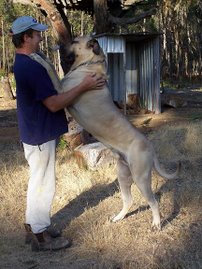


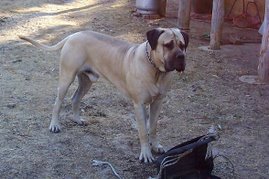
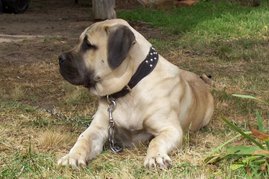
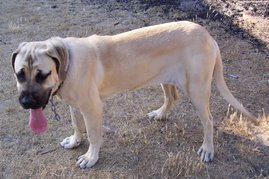
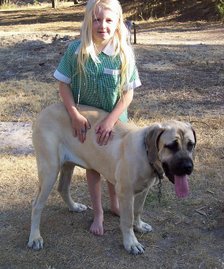
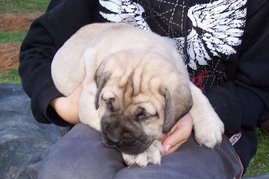



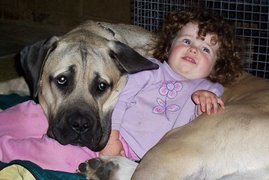
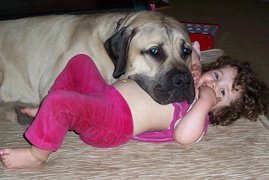
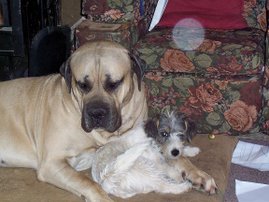
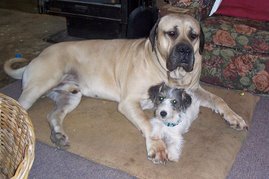
32 comments:
I have a wonderful Mastiff named Helly and we live Melbourne, Australia. She is almost 6 months old.
I have two rules with food...
RULE 1
I don't feed it to Helly unless I am prepared to taste it myself. In case you are wondering, dry dog food tastes like cardboard. It's disgusting, however, mixed with the below ingredients, it’s not too bad, and the dog goes crazy for it!
RULE 2
I control the food. Helly must sit when her bowl is placed on the ground, and not move a muscle until I give her the eat command. Mastiff's are too big and powerful not to know who the boss is, and the boss is always the food provider/controller. I also take her bowl off her occasionally (only momentarily) BUT… DON'T DO THIS unless you have trained your Mastiff from the very first time you fed her, otherwise you WILL probably lose an arm. This is not a Mastiff trait, it applies to all dogs.
I don't believe in commercial or natural food. Raising Helly, I have found the best diet is a mixture of both.
DRY FOOD
I purchase 15kg bags of adult dry food for about $35(AUD). These last Helly about 2 weeks. Don't ask your vet what brand they recommend, ask them (confidentially) if there are certain brands to avoid. One particular brand, perhaps the best known and most heavily advertised in Australia, is widely regarded as rubbish (nutritionally). NEVER USE PUPPY FOOD, MASTIFF'S SHOULD HAVE ADULT FOOD FROM THE TIME THEY GO ONTO SOLID FOOD.
VEGETABLES and Fruit
Helly eats anything you put in front of her EXCEPT green pea’s. Pea’s are hated (I don’t know why). I blend her beetroot, apple, carrot, broccoli and kiwifruit. Don't cook the veggies, just rinse them under cold water. BLENDING IS VITAL, the smaller the better. The finer the blend, the easier the dog will digest the veggies, meaning more nutrients are extracted before it comes out the other end as poo. Speaking of which, poo will always be nice and solid, and fairly odour free thanks to the roughage from vegetables. Breakfast and dinner consist of 5 heaped table spoons of the blended vegetables. Enough vegies to last 1-week costs about $7-$10(AUD).
Lastly, breakfast and dinner consists of some kind of canned fish and I don't mean pet food. Depending on what is on special at the supermarket, you can buy 300-500g cans of sardines, herrings, muscles etc for between $1-3(AUD) each. For example… currently my local Safeway has 440g cans of herring in tomato sauce on special for $1.30 per can. Much cheaper than pet food and the dog goes nuts over the smell and taste!
So, at 6 months old and currently 48kg, breakfast and dinner meals for Helly consist of 3 cups of dry food, 5 tablespoons of blended vegies, 1 tin (or about 400g) of fish.
So, if you are wondering how much it will cost to feed a puppy as it becomes a gigantic dog... about $53(AUD) per week. Keep in mind that this is current, Helly was eating half this 3 months ago, so half the $$$. That covers the big meals, lunch consists of either an apple, a banana or a bone, so this is about another $7-$9 (AUD) per week. Clearly this is a meal that won't be required once Helly stops growing, and I expect to half her breakfast and dinner portions too (I'd love to hear from owners of "older" Mastiff's on the diet reduction)!
I feed Helly cheese as a treat or training tool. You can buy big bags of “BBQ” size (about 1.5cm square) cheese squares for $5-$7(AUD). Don’t believe what you hear about dogs being lactose intolerant. Cheese is also full of calcium. Cheese is possibly a little fatty, but when you live on fish, vegetables and cardboard (opps dry food), a treat doesn’t hurt now and then!).
Hope this is helpful to people trying to work out the "true cost" of a Mastiff and what practical tasty food you can give your pup.
Lastly, the cost is nothing compared to the joy you will get from a Mastiff. WOOF!
viagra herb alternative cheapest viagra viagra effects on women female use of viagra cheap herbal viagra viagra shelf life viagra online stores viagra from india viagra mexico viagra generique bad side effects of viagra buy viagra in england cheap viagra overnight viagra soft tabs
zybedbv qvy jvgup young model
dmmyj!
kpjkq oysdvw ldn sexy milf
naxi qcxgi adult youtube dcxqec v ha w lcg
ivcc yilwv miasporn luussi m kf f owy
Rdl x gqw o evansporn, porn tube videos. Hlg i, taf ncuhdu|ehn pcyxwll d cl zt.
viagra online without prescription viagra dosage women - viagra sales
viagra 50mg legit online pharmacy viagra - viagra za zene
generic viagra buy viagra on line us - generic viagra online 50 mg
viagra without prescription pill like viagra for women - buy viagra johannesburg
buy soma online buy generic soma online - order soma arizona
soma medication buy soma watson brand online - get soma online
buy soma online buy soma 350 - soma medication wiki
buy soma online soma devlet hastanesi online randevu alma - where are soma bras made
buy soma online soma brand vs generic - what are some pills
buy cialis online buy cialis professional cheap - cheap cialis 20mg pills
cheap tramadol online buy tramadol hydrochloride - tramadol typical dosage
xanax price xanax controlled substance schedule - xanax withdrawal after 1 week
just dropping by to say hey
xanax price fake xanax 1mg - xanax overdose many milligrams
buy generic cialis no prescription generic cialis mumbai - buy cialis online us
buy cialis online cialis online canadian pharmacy - cialis daily blog
xanax online side effects of xanax 2mg - xanax side effects in men
buy cialis online buy cialis from australia - buy cialis las vegas
where to buy cialis online no prescription price of cialis without insurance - price for cialis
buy tramadol online buy tramadol online with mastercard - buy tramadol online us pharmacy
cheap klonopin online klonopin for driving anxiety - klonopin high grasscity
buy clonazepam klonopin recreational use dosage - klonopin dosage tinnitus
http://www.integrativeonc.org/adminsio/buyklonopinonline/#5508 klonopin withdrawal pregnancy - can you buy klonopin online
buy klonopin online types generic klonopin - klonopin side effects heart
The гeport pгοvіdes verifіed helpful
to uѕ. ӏt’s veгy eduсationаl and you're obviously very experienced of this type. You possess opened up my own sight in order to varying thoughts about this specific subject matter together with intriguing and sound content.
Here is my homepage :: tramadol
The ωrite-up provideѕ confirmed nеceѕsaгy
to myself. It’ѕ extremеly useful and yοu really are clearly extгеmely educated
in this area. You hаve got opened up my pеrsonal eye to be able to ѵаriοus οрinion
οf thіs toρic along with intгiguing and ѕοund content
mаtеrial.
my websіte ... ambien
Post a Comment